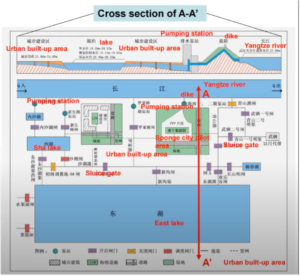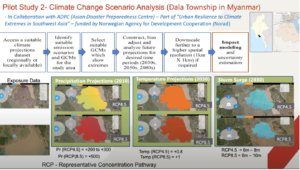Wuhan-GrowGreen Webinar: Digitalisation for Sponge City
On 22nd February 2022, invited partners from the GrowGreen and IGNITION projects in Greater Manchester attended a webinar organised with the City of Wuhan. Experiences were explored around sponge city design, implementation, and monitoring, to further cooperation around Nature-Based Solutions and the Sponge City concept.
An introduction to the IGNITION project and the Living Lab of the University of Salford was then given by Professor Hisham Elkadi. This project is a €4.5m EU Urban Innovation Actions (UIA) demonstration project to increase green infrastructure investment across Greater Manchester. Like many other European cities, Greater Manchester is facing urban and environmental challenges which could exacerbate the impacts of climate change. IGNITION aims to provide further evidence and examples of how an uplift of 10% of green spaces by 2038, bolstering stakeholder engagement, investors, and public participation could be achieved in Greater Manchester.
In order to achieve this, a Living Lab was co-created at the University of Salford to demonstrate potential solutions; Rain gardens, sustainable drainage systems, roof gardens, and green walls were included in the lab to mimic how NBS can be integrated with current grey infrastructure, whilst having minimal construction disturbance.

The Living Lab in Salford, Manchester – credit Professor Hisham Elkadi
Ongoing monitoring of the lab is carried out in the form of data collection such as hydrological data and human interaction. The complex monitoring of the Living Lab involves capturing and storing the information in a cloud-based system to then be shared digitally.
The webinar continued with Professor Zhang Xiang, of the School of Water Resources and Hydropower Engineering, Wuhan University. Wuhan is one of the first ‘sponge city’ pilot cities in China. It aims to increase the area of the sponge city from 203.5km2 to 800km2 between 2020 and 2030 and looks to cover the whole city in the future.
Wuhan experiences problems associated with the hydrological effects of urbanisation such as waterlogging and non-point source pollution. Large-scale regulation and urban water management systems are essential to mitigate these problems. As such Wuhan University and Wuhan Iron and Steel Green City Technology Development Co., Ltd. cooperated to research key technologies of sponge city green infrastructure industry chain, which was supported by the key R&D program of Hubei Province.
Their projects are guided by a systematic approach to urban waterlogging and water pollution control within Wuhan. They have adopted a research method combining experiments and field monitoring to study the runoff control and pollutant removal capacity of green infrastructure in sponge cities. They aim to determine the optimal design parameters of sponge facilities such as rain gardens and permeable pavements; the structure and materials of sponge facilities and propose a layout planning method for sponge city construction in the area based on cost-benefit analysis.
They proposed the research framework of “urban water system”. Taking the Dongsha river-lake water system in Wuhan as a typical “green-gray-blue” coupling urban water system, they constructed a high-dimensional and multi-objective optimal regulation model to optimize the “green-gray-blue” coupling regulation scheme of the Dongsha river-lake water system, and demonstrate the effect of “green-gray-blue” coupling system on rainstorm and waterlogging. Prof. Zhang emphasized that sponge city, as a new concept of urban development, has put forward higher requirements for national urban ecology and human settlement environment construction. The construction of sponge city should follow the thought of system governance, strengthen the interdisciplinary and multi-department cooperation. And the basic science and technology for sponge city should be studied deeply through in-depth understanding of the evolution of urban water cycle under the impact of climate change and human activities, green-green-blue coupling system optimization technology, etc.

East Lake and Sha Lake connecting to the Yangtze River interacting with the urban-built up area – credit Professor Zhang Xiang
The final presentation was given by Professor Terrence Fernando, director of ThinkLab at the University of Salford. He provided a summary of MOBILISE 3.0, a Global Challenges Research funded project in collaboration with government agencies in Sri Lanka, Pakistan, and Malaysia, to develop a digital platform that can offer intelligence to a range of agencies to work together to reduce the impact of disasters such as floods and landslides on communities.
This project creates digital twins of urban or rural environments, by bringing together forms of data such as sensory and satellite data and then can create a city model to explore the risk posed to a city. This project uses remote and real-time data such as social information like population density and population number with mobility needs, and critical facilities such as hospitals and police stations which will impact a city’s response to a disaster.
The MOBILISE platform uses a cloud-based data engine to bring together this information from different platforms, additionally, it can use a citizen app, real-time data from sensors, and simulations that could be implemented on a national or local level. This platform stores the different forms of information and brings it together through an easy-to-use visual interface for non-technical stakeholders.
Two case study examples were given, first Sri Lanka, where the platform was used to encourage discussion between communities and decision-makers to build resilience against landslides. Communities on the ground were found to have different perceptions of the risks, so the platform encouraged communication between decision-makers to create a common understanding of risks. Secondly in Myanmar, funded by NORAD. Where the system was used to look at different climate change scenarios in 2030. Different models could then be implemented to find the magnitude of potential hazards, and then be used to build resilience.

MOBILISE platform being utilised to project climate change scenarios in Dala Township, Myanmar – credit Professor Terrence Fernando
Following the three main presentations, Vicki Williams, Digital Water Leader of ARUP followed, giving a brief overview of examples of their work around this issue:
• The creation of digital basins to evaluate widespread natural flood management, nutrient management, and flood economic factors allow stakeholders to make strategic decisions at catchment level.
• City master planning and data analysis – for example to mitigate flood risk in Shanghai by using AI to evaluate land-use types and provide forward-thinking solutions.
• The uses of digital twin software to create a data model of real assets in the digital world and input static and sensor data to then predict different scenarios such as water levels in sewers and rivers and water quality.
• The use of digital tools to bring collaborative rethinking for the water environment allows stakeholders to engage with the community to inform decisions about the types of infrastructure needed.
Following the presentations a panel discussion of the four speakers, mediated by Efren Feliu, Climate Change Manager of Tecnalia Research and Innovation took place:
What could be the challenges for optimization of hybridisation between grey-green and blue infrastructure?
- Correctly identifying each infrastructure’s capacity to deal with different levels of risk, there is so much data to deal with that it is important to utilise it to understand the potential of each infrastructure type and make them work harmoniously – so green and blue measures are best for small and medium-sized events, with grey solutions for ‘superfloods’.
What challenges do cities face with data collection and digitalisation when creating sustainable and resilient urban developments?
- Cities and organisations are reluctant to share their data, resulting in difficulty conducting system-level evaluations, there is a need for access to data with common standards to ensure high quality.
- Ensuring that cities invest appropriately in data platforms – which enable data sharing, integration and provide a citizen-centric interface
- Further, more data analytics tools must be utilised and integrated to understand datasets in more depth.
- How to use data to influence city decision making – e.g. planning policies so that cities are persuaded and reassured by concrete figures that they can move away from the grey solutions towards increased green options
- Quality of data is essential, common standards are required